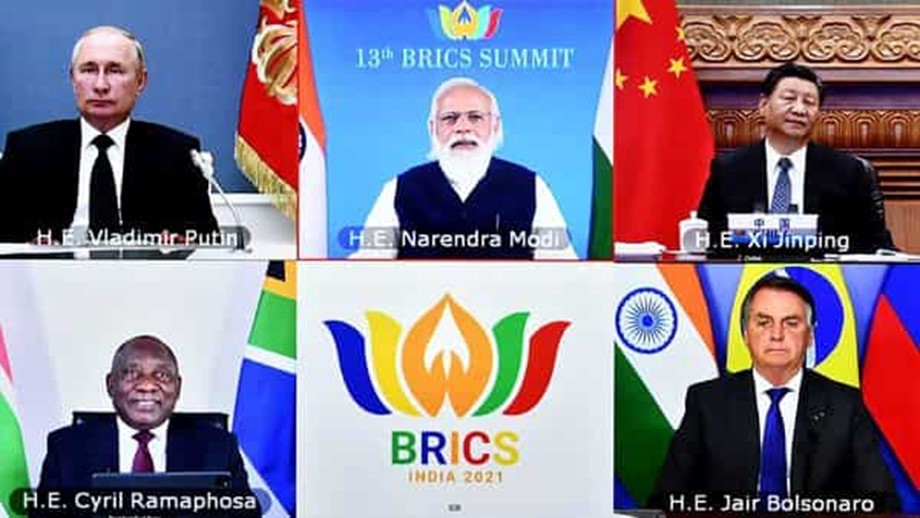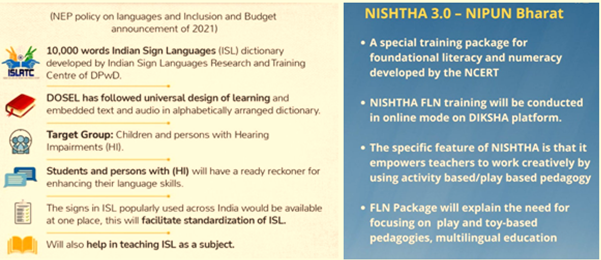Tuesday, 14th September 2021
Resolution before NCLT can’t be modified: SC
In News
Recently, the Supreme Court ruled that the National Company Law Tribunal (NCLT) cannot modify successful Corporate Insolvency Resolution Plans, under the IBC.
About the News
- No modifications: Modifications or withdrawals of Resolution Plans can't be allowed once the plans are approved by the Committee of Creditors at the behest of the successful Resolution Applicant.
- Any modifications must specifically provide for a tether under the IBC and it must be coupled with directions on which such actions are permissible and procedural directions.
- Adherence to the timeline: Resolution Process carried out under the Insolvency and Bankruptcy Code (IBC) must be completed within 330 days. It can be extended only in exceptional circumstances.
- Binding Resolution: The SC noted that a submitted resolution plan is binding and irrevocable between the CoC and the successful resolution applicant in terms of the provisions of the IBC and the CIRP regulations.
Significance of the ruling
- Prevent a new tier of negotiations: Stopping the modifications by NCLT would prevent creation of another tier of negotiations, which are unregulated by the IBC.
- Reduces time delay: The ruling would help reduce the timeline in the IBC resolution process.
- Any delay would have a deleterious impact on the corporate debtor, its creditors, and the economy at large as the liquidation value depletes with the passage of time.
- Clears ambiguity: The issue of modification is crucial since the IBC is silent on the aspect of withdrawal of a resolution plan while the NCLT had taken a view in a judgement last year that an application to withdraw from the resolution plan was permissible.
About the Insolvency and Bankruptcy Code
- Insolvency and Bankruptcy Code is a reform enacted in 2016 amalgamating various laws relating to the insolvency resolution of business firms.
- It lays down clear-cut and faster insolvency procedures to help creditors, such as banks, recover dues and prevent bad loans.
- It was introduced when insolvency resolution took around 4 years on an average. Therefore, completing the resolution process within a fixed timeline was at the heart of this framework.
- Generally, the CIRP has to be completed within 330 days from the Commencement of Insolvency Proceedings. However, it is subject to certain exclusions.

Sources:
A boost for textile sector
In News
In recent times, the Government has taken various steps including the Production Linked Incentive (PLI) Scheme to boost the textile sector.
About the New Initiatives
- PLI for Textiles: Taking steps forward towards the vision of an ‘Aatmanirbhar Bharat’, the Government has approved the PLI Scheme for Textiles with a budgetary outlay of 10,683 crore.
- PLI scheme for Textiles will promote production of high value MMF Fabric, Garments and Technical Textiles in country. The incentive structure has been so formulated that industry will be encouraged to invest in fresh capacities in these segments.
- R & D Promotion: Government has also launched a National Technical Textiles Mission for promoting R&D efforts in the sector.
- The Technical Textiles segment is a new age textile, whose application in several sectors of economy, including infrastructure, water, health and hygiene, etc. will improve the efficiencies in those sectors of economy.
Need for Promoting the Textile Sector
- Scale: Scale is important to bring down the cost of production and to improve productivity levels to match global benchmarks. Also, with growing awareness on social and environmental issues, global buyers are looking for more compliant, sustainable and large factories to place bulk orders.
- The PLI scheme rolled out for the textile sector incentivizes scale, and Return on capital employed (ROCE) will be high for companies investing in this scheme.
- Specialization: India has built a strong ecosystem in cotton apparels, but is lagging in man-made fibre (MMF) apparel manufacturing where India has a share of just 5%.
- PLI addresses this friction point by incentivizing the manufacturing of MMF apparel and fabrics.
- Competitiveness: To compete with low-cost competitors, India needs to be ultra-efficient in pricing.
- With assured production incentives in the PLI scheme, entrepreneurs with growth aspirations will boldly invest in integrated smart factories which would help achieve world-class productivity and manufacturing efficiency.
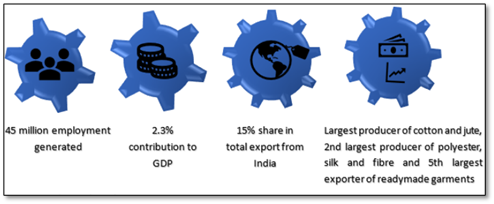
Sources:
Government has approved Production Linked Incentive (PLI) Scheme for Textiles
India plans space sector boost in global market
In News
AS per ISRO, India will soon allow overseas companies to invest in the space sector with a revised foreign direct investment (FDI) policy.
About the News
- About: The space foreign direct investment policy is getting revised and it will open huge opportunities for space companies to invest in India.
- Overseas Engagement: It will ensure sustained engagement between Indian and overseas companies that will greatly benefit both. With this policy, space sector will not only be open in India but also to foreign investments.
- ISRO on the other hand will concentrate on research and development as well as space science missions.
- Global Share: With this policy, India will set targets to increase its share in the global space economy from less than 2% at the moment to 10%.
- Space economy: All the industries (rocket and satellite manufactures, telecommunications, agriculture, climate change researchers, banking, Defence, Space tourism etc.) that come together to create the ecosystem above our heads that make modern day, digital life possible.
Constraints to the growth of Space economy in India:
- Regulatory void:
- The regulatory mechanisms for IN-SPACe, by which it will be able to take action against erring space players, is currently under review.
- Draft space activities bill, 2017 which provides a regulatory framework, but has not been tabled yet.
- Lack of investment:
- ISRO’s budget hasn’t significantly increased in recent times.
- Investment by space sector startups in India is just $21 to $22 million, which is less than 0.5% of that by global startups.
- Capacity constraints such as lack of human resources, facilities
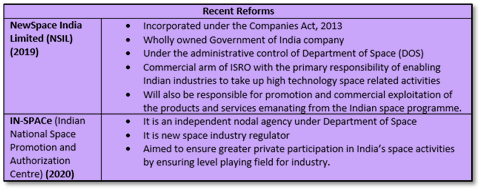
Sources:
Women Reservation Bill
In News
The year 2021 marks 25 years of introduction of Bill for Women’s Reservation in Parliament and State assemblies, the most recent version of which was introduced in 2008 and lapsed with 15th Lok Sabha.
Key facets of the Women's Reservation Bill, 2008
The Bill aims at eliminating gender inequality and discrimination against women, by political empowerment of women, to fulfill people’s mandate of Women Empowerment and seeks:
- To reserve one-third of all seats for women in the Lok Sabha and the state legislative assemblies.
- To reserve one third of the total number of seats reserved for Scheduled Castes and Scheduled Tribes shall be reserved for women of those groups in the Lok Sabha and the legislative assemblies.
- To allot the reserved seats by rotation to different constituencies in the state or union territory.
- To create a sunset clause by stating that reservation of seats for women shall cease to exist 15 years after the commencement of this Amendment Act.
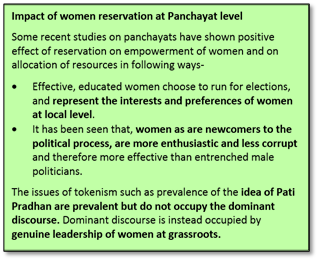
Why is women reservation important?
- For creation level playing field: The political dynamics in India has been traditionally dominated by money and muscle power. Women fare poorly in both these departments given their limited economic empowerment. Reservation of seats could help bypass this hurdle.
- Limited political participation can be in the data highlighted by the infographic.
- For achieving the ‘critical mass’: It has been argued that reservation in needed to take women political representation to a ‘critical mass’, for any real change to take place.
- This may lead to an influence on political norms and culture. Further opening the gates for political participation of women.
- Reluctance of major political parties to give more tickets to women candidates. Such parties enjoy legitimacy and clout. Reservation could deter this indirect discrimination.
- Spillover effect of political empowerment: Women having the possibility to influence the decision-making process as individuals or with specific points of view and concerns indirectly enhances social-economic as well as cultural empowerment of women.
- Evidence suggesting effectiveness of reservation: There is enough empirical evidence to suggest that Feminisation of political governance leads to changes in public policy decisions and expenditure patterns. (Refer box)
What are the challenges in implementing it?
- Lack of political consensus: The Women Reservation Bill has been tabled multiple times, referred to Standing Committees and remains unfinished for want of political consensus.
- Stereotypical gender perceptions: Some sections don’t not see women as capable enough to hold positions in the government and reservation is seen as a threat to male hegemony and the moral fabric of society.
- Although, some sections oppose women reservation citing an opposite logic i.e., reservation would perpetuate unequal status of women since they would not be perceived to be competing on merit.
- Limited change in women empowerment at political party level: Political parties are the real gatekeepers to political offices. Unless and until, the effect of reservations provides real power to women at political party level, the law would be limited to mere tokenism.
- Overhang of Government of India (GoI) Act, 1935: The GoI Act, extended separate electorates to women. This gave impetus to the widespread sense of fear and suspicion that reservation for women would be disruptive as it would pit women against men. This argument still holds validation among some sections.

- Other arguments against reservation:
- Reservation policy diverts attention from the larger issues of electoral reform such as criminalization of politics and inner party democracy.
- Reservation may clash with the principle of the voters’ right to choose the representatives they want.
- Rotation of reserved constituencies in every election may reduce the incentive for an MP to work for his constituency as he may be ineligible to seek re-election from that constituency.
What can be done to overcome these challenges and effect political empowerment of women?
- Maintaining a persistent political discourse: This will help improve the ability of political parties to generate consensus on the issue, as critical points would already be a part of public debate.
- It will also encourage swift passing of the associated legislation in the parliament.
- Sensitization of the issue among parties and voters: The opposition in the public and political party level is due lack of awareness about the gravity of the problem. Sensitization could create a strong public opinion in favor of reservation and pushing gender equality at the political party level.
- Effective implementation and enforcement if the law comes to fore: This implies having clear and precise guidelines, sanctions for non-compliance with the guidelines and ensuring that law is being applied in both letter and spirit.
- Exploration of alternate methods: Some experts have suggested alternate methods such as reservation of women in political parties and nominations and creation of dual member constituencies.
- Simultaneous strengthening of other initiatives for empowerment of women: Pursuance of the policy of reservation needs to be accompanied by strengthening of initiatives like Gender Budgeting, Stand-Up India among others to ensure the desired impact.
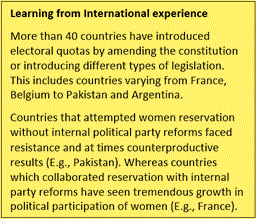
Conclusion
Reservation provisions may not solve all problems for women in politics and that they may even create new ones. However, it might make it possible for women to surmount some of the barriers that prevent access to certain opportunities. They could enable a ‘jump start’ where women have almost no representation at all.
Further, political representation cannot stand alone, but must be complemented with necessary socio-economic changes in society at large. This societal change in turn percolates from the individual effort which creates a ripple effect of change and transformation.
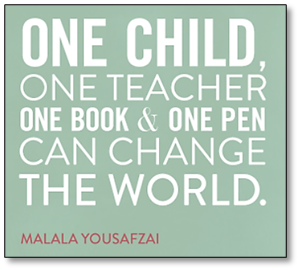
Question: Elaborate on the need for the women reservation in India. What have been the major roadblocks to women reservation in India?
Sources:
- https://rajyasabha.nic.in/rsnew/publication_electronic/reserv_women_pers2008.pdf
- https://sticerd.lse.ac.uk/eopp/_new/data/indian_project/papers/Women_Reserve.pdf
- https://www.dnaindia.com/analysis/column-let-s-talk-women-s-reservation-2805945
- https://www.brookings.edu/blog/up-front/2019/10/18/womens-reservation-bill-what-can-india-learn-from-other-countries/
- https://prsindia.org/billtrack/womens-reservation-bill-the-constitution-108th-amendment-bill-2008-45
- https://prsindia.org/theprsblog/update-on-the-women’s-reservation-bill
- https://www.aljazeera.com/news/2021/9/8/25-years-india-women-reservation-bill-elected-bodies-gender
Hindi Diwas
On September 14, 1953, the first Hindi Diwas was celebrated. India celebrates Hindi Diwas, also known as Hindi Day, every year to commemorate the adoption of Hindi in the Devanagari script as one of the official languages of the nation. The Constituent Assembly of India accepted Hindi, written in Devanagari script, as the official language of India on September 14, 1949. The reason behind adopting Hindi as one of the official languages was to simplify administration in a nation with multiple languages. Rajbhasha Kirti Puraskar and Rajbhasha Gaurav Puraskar awards are also given to ministries, departments, public sector units (PSUs), nationalised banks and citizens on Hindi Diwas for their contribution and promotion of Hindi.
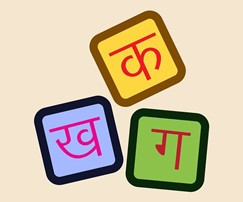
Sources:
Zapad-2021
This is image of the main stage of the joint strategic exercise Zapad-2021, which is being held at the Mulino training ground in the Nizhny Novgorod region of Russia. The Indian Army contingent carried out a joint rehearsal of the Special Heliborne Operation (SHBO). During the main stage of the exercises, Russian army units, jointly with military contingents from military contingents of the armed forces of Armenia, Belarus, India, Kazakhstan, Kyrgyzstan, and Mongolia are taking part in practical actions as part of the coalition group of troops, to conduct flexible defense, to deliver targeted fire attack and crush the enemy.
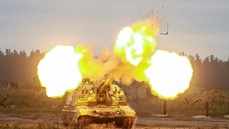
Source:
Climate Action and Finance Mobilization Dialogue (CAFMD)
- Context: India and the USA have launched the CAFMD.
- The CAFMD is one of the two tracks of the India-U.S. Agenda 2030 partnership launched in 2021, the other being Strategic Clean Energy Partnership.
- The dialogue aims to strengthen the India-US bilateral cooperation on climate and environment.
- It will also help to demonstrate how the world can align swift climate action with inclusive and resilient economic development, taking into account national circumstances and sustainable development priorities.
- India has already achieved 100 GW, out of the target of achieving 450GW renewable energy by 2030.
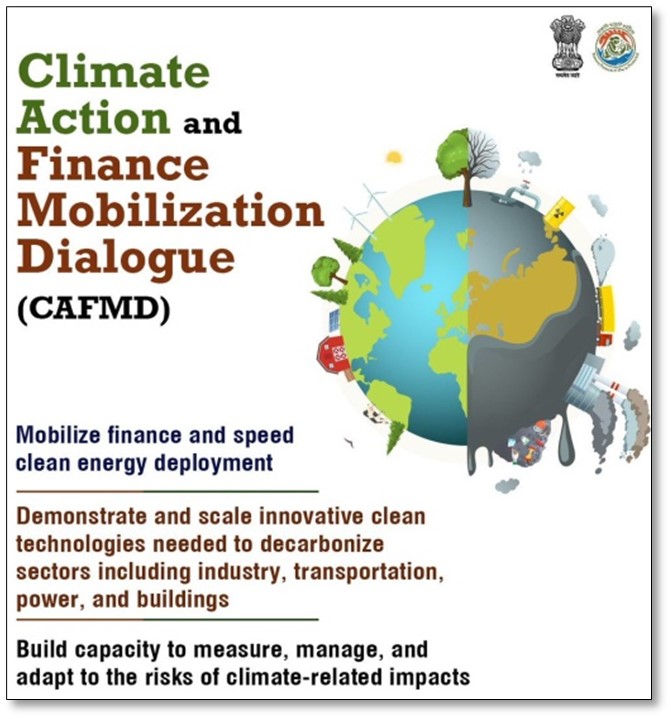
Source:
- India and US launch the Climate Action and Finance Mobilization Dialogue (CAFMD)
- India, US to launch Climate Action and Finance Mobilisation Dialogue
Image source :
https://twitter.com/moefcc?lang=gl
Oriental white-backed vultures
- Context: Eight Oriental white-backed vultures were released into the wild from the Bir Shikargah Wildlife Sanctuary.
- The IUCN status of this vulture is critically endangered
- Bir Shikargah Wildlife Sanctuary is a designated Eco sensitive zone, situated in Panchkula, Haryana which houses the vulture conservation and breeding centre, Pinjore.
- The Oriental white-backed vulture (Gyps bengalensis) is an Old World vulture that belongs to the family Accipitridae, which also includes eagles, kites, buzzards and hawks.
- These are resident birds and are non migratory, which stay within a radius of 50-100 km of the breeding centre.
- Their population has declined by over 97% since the 1990s due to the uncontrolled veterinary usage of non-steroidal anti-inflammatory drugs (NSAID), including Aceclofenac, Ketoprofen, Nimesulide, and the illegal use of the banned drug Diclofenac.

Source:
Saline Gargle RT-PCR technique
- Context: The National Environmental Engineering Research Institute (NEERI) has transferred the Saline Gargle RT-PCR technique to MSME Ministry.
- The Saline Gargle RT-PCR technology is a simple, fast, economical, environment and patient-friendly technique used for testing COVID-19 samples.
- It is well-suited for rural and tribal areas with poor connectivity as it has minimal infrastructure requirements.
- Sampling is done instantly and results are generated within three hours.
- A simple collection tube filled with a saline solution is used. The patient gargles with the solution and rinses it inside the tube.
- The sample is then taken to a laboratory where it is kept at room temperature in a special buffer solution and an RNA template is produced when this solution is heated, which is further processed for RT-PCR test
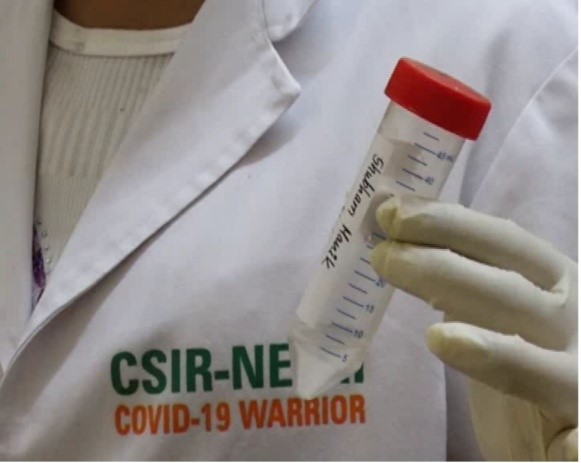
Source:
Shape-shifting
- Context: Animals have been found to shape-shift to cope with warming climate.
- Shapshifting is based on Allen’s rule which states that animals which live in cold climatic conditions tend to have shorter limbs and body appendages than those in warm climates.
- Animals adopt ‘shapeshifting’ physiology as a survival strategy against the rising mercury levels.
- Particularly, some warm-blooded animals like birds are found to be shapeshifting to advance features like bigger beaks, legs, and ears to balance their body temperatures parallel to warmer climates.
Sources:
- Animals ‘Shapeshift’ to Cope with Warming Climate: Study
- Climate change: Animals 'shape-shifting' in response to global warming crisis, study says:
Can the Shanghai Cooperation Organisation be the regional body that stabilises Afghanistan?- IE
Essence: The article talks about the recent summit meeting of the Shanghai Cooperation Organisation and the fact that it has not been able to maintain cordial relations with Central Asia in comparison to others like Europe and East Asia. Afghanistan political upheaval should be considered as a challenge for revival for the SCO, more so when Russia and China have vital interests in Afghanistan.
With SCO expanding its membership, possibility of institutional cooperation becomes a bigger challenge. The precursor institution, “Shanghai Five” had its agenda to build shared Sino-Russian interest and preventing American meddling in their Central Asian backyard. Moscow is reluctant to back Chinese proposals to promote trade integration under the SCO banner. And China is not a member of either CSTO or EAEU (which Russia promotes). These are some examples of the glimmering fractures within SCO members. Considering SCO’s Afghanistan agenda, and Russia-China interests, Delhi must focus on finding common ground with those members of the SCO who do share India’s concerns about Afghanistan.
Why you should read this article?
- To understand the strategic importance of SCO in the Asian continent.
- To understand the power struggle between China and Russia and their contrasting interests.
- To understand India’s role in the SCO.
Source-
Can the Shanghai Cooperation Organisation be the regional body that stabilises Afghanistan?
How to boost financial inclusion- IE
The article talks about moving from financial inclusion to financial integration. India as an economy has certainly progressed on financial inclusion but lacks when it comes to financial integration. This can be made possible only when the financial products are made accessible relevant, applicable, and acceptable.
The challenges could range from lack of capital, challenging regulatory oversight, limited risk appetite etc. What we need is the customised or tailor-made products according to the different sections of society and not the one-size-fits-all approach. Also using the power of machine learning and cloud infrastructure can significantly change the game.
Why you should read this article?
- To understand how can we move from financial inclusion to financial integration.
- What are the challenges in integrating the Indian economy.
Source:
Returning to school 17 months later- TH
Essence: We have two approaches to teaching; one is where we left in the syllabus approach and the other is treating every child as different and emotionally caring for them. The closure of schools and adaptation of online classes had led to learning loss and weakening of psychological bond between teachers and children. This could lead to impatience among teachers who follow the first method. Including creative arts curriculum to heal the wound of covid trauma and reorganise this year's curriculum could go a long way to handle the re-initiation of schools.
Why you should read this article?
- To understand the nuances of different teaching styles.
- To know about the impact the closure of schools and online education has on children and teachers.
- To understand the ways to address the concerns arising due to reopening of schools after a long gap.
Source:
Master Moshai
Background
- Unavailability: shortage of good schools in rural locality in Burdwan, WB
- Nearest college- 32 km away
Sadai Fakirer Pathshala
- Resource: 76-year-old retired principal of Ramnagar Uccha Madhyamik Vidyalaya
- Priority area: girl child education
- First Generation Learners: serving the underserved rural population
- Token Fee: charging a mere amount of Rs. 2/year as a sign of respect for the teachers
Allied Initiatives
- Socio-environmental awareness
- Started campaigning for Thalassemia awareness
Things to learn
- Compassion, Empathy, Community Service, Dedication, Altruism
Quote
Not all of us can do great things, but we can do small things with great love.— Mother Teresa
Where can it be used:
- Paper 4: Human Values - Lessons from the Lives and Teachings of Great Leaders
- Paper 4: Dedication to Public Service, Empathy, Tolerance and Compassion towards the weaker sections.
Source:
Share the article
Get Latest Updates on Offers, Event dates, and free Mentorship sessions.

Get in touch with our Expert Academic Counsellors 👋
FAQs
UPSC Daily Current Affairs focuses on learning current events on a daily basis. An aspirant needs to study regular and updated information about current events, news, and relevant topics that are important for UPSC aspirants. It covers national and international affairs, government policies, socio-economic issues, science and technology advancements, and more.
UPSC Daily Current Affairs provides aspirants with a concise and comprehensive overview of the latest happenings and developments across various fields. It helps aspirants stay updated with current affairs and provides them with valuable insights and analysis, which are essential for answering questions in the UPSC examinations. It enhances their knowledge, analytical skills, and ability to connect current affairs with the UPSC syllabus.
UPSC Daily Current Affairs covers a wide range of topics, including politics, economics, science and technology, environment, social issues, governance, international relations, and more. It offers news summaries, in-depth analyses, editorials, opinion pieces, and relevant study materials. It also provides practice questions and quizzes to help aspirants test their understanding of current affairs.
Edukemy's UPSC Daily Current Affairs can be accessed through:
- UPSC Daily Current Affairs can be accessed through Current Affairs tab at the top of the Main Page of Edukemy.
- Edukemy Mobile app: The Daily Current Affairs can also be access through Edukemy Mobile App.
- Social media: Follow Edukemy’s official social media accounts or pages that provide UPSC Daily Current Affairs updates, including Facebook, Twitter, or Telegram channels.


